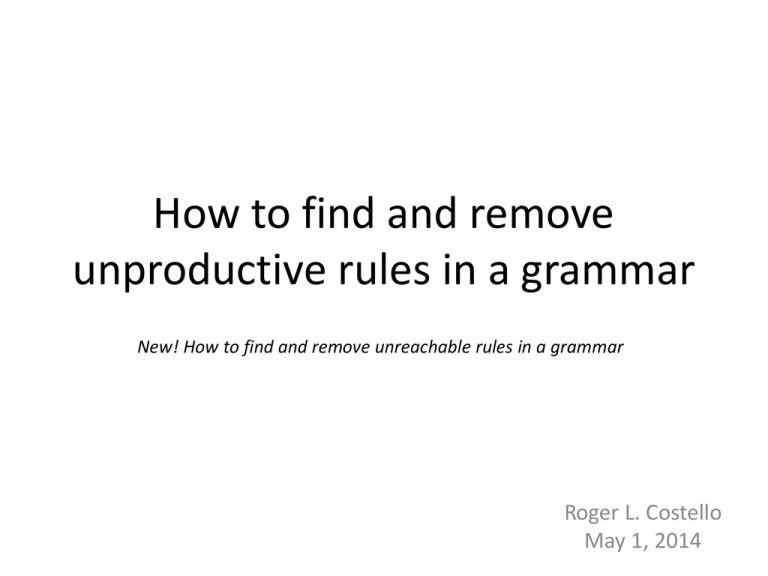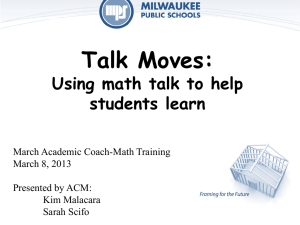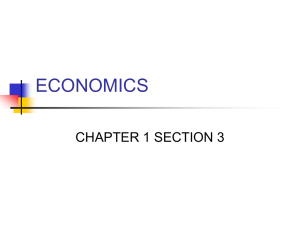How to find and remove unproductive rules from a grammar
advertisement

How to find and remove
unproductive rules in a grammar
New! How to find and remove unreachable rules in a grammar
Roger L. Costello
May 1, 2014
Objective
This mini-tutorial will answer these questions:
1. What are unproductive grammar rules?
2
Objective
This mini-tutorial will answer these questions:
1. What are unproductive grammar rules?
2. Why remove unproductive rules?
3
Objective
This mini-tutorial will answer these questions:
1. What are unproductive grammar rules?
2. Why remove unproductive rules?
3. Is there an intuitive algorithm to find
unproductive rules?
4
Objective
This mini-tutorial will answer these questions:
1. What are unproductive grammar rules?
2. Why remove unproductive rules?
3. Is there an intuitive algorithm to find
unproductive rules?
4. Intuition is a dangerous master; is there a
precise, formal algorithm to find unproductive
rules?
5
Objective
This mini-tutorial will answer these questions:
1. What are unproductive grammar rules?
2. Why remove unproductive rules?
3. Is there an intuitive algorithm to find
unproductive rules?
4. Intuition is a dangerous master; is there a
precise, formal algorithm to find unproductive
rules?
5. Can we identify and eliminate unproductive
rules in XML Schemas?
6
Objective
This mini-tutorial will answer these questions:
1. What are unproductive grammar rules?
2. Why remove unproductive rules?
3. Is there an intuitive algorithm to find unproductive
rules?
4. Intuition is a dangerous master; is there a precise,
formal algorithm to find unproductive rules?
5. Can we identify and eliminate unproductive rules in
XML Schemas?
6. New! What are unreachable rules, how do we
identify them, and how do we eliminate them?
7
Context-free grammars
• The following discussion shows a systematic
procedure for finding and eliminating
unproductive rules in context-free grammars.
– Finding and eliminating unproductive rules is
decidable for context-free grammars.
• There is no procedure for finding and eliminating
unproductive rules in context-sensitive or phrasestructure grammars.
– Finding and eliminating unproductive rules is
undecidable for context-sensitive and phrasestructure grammars.
8
S
S
A
B
→
→
→
→
A
B
a
bB
This is a productive rule. It generates a
string: S → A → a
9
S
S
A
B
→
→
→
→
A
B
a
bB
This is an unproductive rule. It does not
generate a string: S → B → bB → bbB →
bbbB → bbbbB → … (the production
process never terminates)
10
Definition
• A rule is productive if at least one string can be
generated from it.
• A productive rule is also known as an active
rule.
11
Why remove unproductive rules?
• Unproductive rules are not a fundamental
problem: they do not obstruct the normal
production process.
• Still, they are dead wood in the grammar and
one would like to remove them.
• Also, when they occur in a grammar specified
by a programmer they probably point at some
error and one would like to detect them and
give warning or error messages.
First, find productive rules
• To find unproductive rules we will first find the
productive rules.
• The next few slides show an algorithm for
finding productive rules.
Algorithm to find productive rules
• A rule is productive if its right-hand side
consists of symbols all of which are
productive.
• Productive symbols:
– Terminal symbols are productive since they
produce terminals.
– Empty (ε) is productive since it produces the
empty string.
– A non-terminal is productive if there is a
productive rule for it.
14
Example grammar
S
S
A
B
C
D
E
F
→
→
→
→
→
→
→
→
A
D
a
b
c
d
e
f
B
E
C
F
D
The above grammar looks innocent: all its nonterminals are defined and it does not exhibit any
suspicious constructions.
15
Initial knowledge
Go through the grammar and for each rule for
which we know that all its right-hand side symbols
are productive, mark the rule and the non-terminal
it defines as Productive.
Rule
Productive
S → A B | D E
A → a
Productive
B → b C
C → c
Productive
D → d F
E → e
Productive
F → f D
16
Build on top of our knowledge
Now we know more. Apply this knowledge in a
second round through the grammar.
Rule
Productive
S → A B | D E
A → a
Productive
B → b C
Productive (since b is productive and C is productive)
C → c
Productive
D → d F
E → e
Productive
F → f D
17
Round three
Rule
Productive
S → A B
S → D E
Productive (since A is productive and B is productive)
A → a
Productive
B → b C
Productive (since b is productive and C is productive)
C → c
Productive
D → d F
E → e
Productive
F → f D
18
Round four
A fourth round yields nothing new.
Rule
Productive
S → A B
S → D E
Productive (since A is productive and B is productive)
A → a
Productive
B → b C
Productive (since b is productive and C is productive)
C → c
Productive
D → d F
E → e
Productive
F → f D
19
Recap
We now know the rules for A, B, C, E and the rule
S → A B are productive. The rules for D, F, and the
rule S → D E are unproductive.
Rule
Productive
S → A B
S → D E
Productive (since A is productive and B is productive)
A → a
Productive
B → b C
Productive (since b is productive and C is productive)
C → c
Productive
D → d F
E → e
Productive
F → f D
20
Remove unproductive rules
We have pursued all possible avenues for
productivity and have not found any possibilities for
D, F, and the second rule for S. That means they are
unproductive and can be removed from the
grammar.
Rule
Productive
S → A B
Productive (since A is productive and B is productive)
A → a
Productive
B → b C
Productive (since b is productive and C is productive)
C → c
Productive
E → e
Productive
The grammar after removing unproductive rules
21
Bottom-up process
Removing the unproductive rules is a bottom-up
process: only at the bottom level, where the
terminal symbols live, can we know what is
productive.
22
Find productive rules first
We found the unproductive rules by finding the
productive rules. After finding all productive
rules, the other, remaining rules are the
unproductive rules.
23
Knowledge-improving algorithm
• In the previous slides we increased our
knowledge with each round.
• The previous slides illustrate a closure
algorithm.
24
Closure algorithm
Closure algorithms are characterized by two components:
1. Initialization: an assessment of what we know initially.
For our problem we knew:
The grammar rules
Terminals and empty are productive
2. Inference rule: a rule telling how knowledge from several
places is to be combined.
The inference rule for our problem was:
If all the right-hand side symbols of a rule are productive, then
the rule’s left-hand side non-terminal is productive.
The inference rule is repeated until nothing changes any
more.
25
Subject to misinterpretation
The closure algorithm that we used (below) is
expressed in natural language. Natural
languages are prone to misinterpretation.
Algorithm to find productive rules
• A rule is productive if its right-hand side
consists of symbols all of which are productive.
• Symbols that are productive:
– Terminal symbols are productive since they produce
terminals.
– Empty is productive since it produces the empty
string.
– A non-terminal is productive if there is a productive
rule for it.
26
Razor-sharp precision desired
The following slides present a formal, succinct,
precise algorithm for finding productive nonterminals.
Avoid Ambiguity
• Where possible it is desirable to express things
mathematically, using equations. Why?
Because an equation avoids the clumsiness
and ambiguity of verbal descriptions.
• Likewise, where possible it is desirable to
express algorithms formally, using
standardized symbols. Why? Because
standardized symbols avoids the clumsiness
and ambiguity of verbal descriptions.
Identify rules with the form: X → a
Algorithm to find productive rules
• A rule is productive if its right-hand side
consists of symbols all of which are productive.
• Symbols that are productive:
– Terminal symbols are productive since they produce
terminals.
– Empty is productive since it produces the empty
string.
– A non-terminal is productive if there is a productive
rule for it.
Identify rules that use just
terminal symbols or ε
(empty). Create a set
consisting of the rules’
non-terminals.
29
Symbols we will use
Let:
VN denote the set of non-terminal symbols
VT the set of terminal symbols
S the start symbol
F the production rules
30
Transformation to a precise expression
Terminal symbols are productive since they
produce terminals. Empty is productive since it
produces the empty string.
Identify rules that use just terminal symbols or
ε (empty). Create a set consisting of the rules’
non-terminals.
A1 = {X | X → P ∈ F for some P ∈ VT*}
“A1 is the set of non-terminals X such that X has the form X → P, the
rule is one of the grammar rules F, and P is zero or more terminal
symbols VT* ”
31
Set A1for our example grammar
These rules have the desired
form. Add their non-terminals
to A1.
S
S
A
B
C
D
E
F
→
→
→
→
→
→
→
→
A
D
a
b
c
d
e
f
B
E
C
F
D
A1 = {X | X → P ∈ F for some P ∈ VT*}
A1 = { A, C, E }
Non-terminal symbols that are productive.
32
A1 corresponds to the
“initial knowledge” diagram
• A1 is the set of non-terminals that have terminal symbols
on the right-hand side.
• {X | X → P ∈ F for some P ∈ VT*} is a precise
specification of what we intuitively did in this diagram:
Rule
Productive
S → A B | D E
A → a
Productive
B → b C
C → c
Productive
D → d F
E → e
Productive
F → f D
33
Productive non-terminals
{ A, C, E }
We have identified these
productive non-terminal
symbols.
34
Identify rules that use terminals and
productive non-terminals
Algorithm to find productive rules
• A rule is productive if its right-hand side
consists of symbols all of which are productive.
• Symbols that are productive:
– Terminal symbols are productive since they produce
terminals.
– Empty is productive since it produces the empty
string.
– A non-terminal is productive if there is a productive
rule for it.
Identify rules that use
terminal symbols and
productive non-terminals.
Create a set consisting of
the rules’ non-terminals.
Merge this set with A1.
35
Rule which uses terminal symbols
and symbols from A1
The right-hand side of
this rule consists of a
terminal and an element
of A1.
S
S
A
B
C
D
E
F
→
→
→
→
→
→
→
→
A
D
a
b
c
d
e
f
B
E
C
F
D
36
Merge (union) sets
{ A, C, E }
{B}
A2 = { A, B, C, E }
37
Formal definition of set A2
A2 = A1 ∪ {X | X → W ∈ F for some W ∈ (VT ∪ A1)*}
“A2 is the union of A1 with the set of non-terminals X that have the form
X → W, the rule is one of the grammar rules F, and W is zero or more
terminal symbols VT and symbols from A1 ”
38
Productive non-terminals
{ A, B, C, E }
We have identified these
productive non-terminal
symbols.
39
Make bigger and bigger sets
Algorithm to find productive rules
• A rule is productive if its right-hand side
consists of symbols all of which are productive.
• Symbols that are productive:
– Terminal symbols are productive since they produce
terminals.
– Empty is productive since it produces the empty
string.
– A non-terminal is productive if there is a productive
rule for it.
Create new sets until
nothing is added to the
next set, i.e., Ai+1 = Ai
40
Rule which uses symbols from A2
The right-hand side of
this rule consists of
symbols from A2.
S
S
A
B
C
D
E
F
→
→
→
→
→
→
→
→
A
D
a
b
c
d
e
f
B
E
C
F
D
41
Distinguish the two rules for S
Let’s call this S1
Let’s call this S2
S
S
A
B
C
D
E
F
→
→
→
→
→
→
→
→
A
D
a
b
c
d
e
f
B
E
C
F
D
42
Merge (union) sets
{ A, B, C, E }
{ S1 }
A3 = { A, B, C, E, S1 }
43
Set A3
A3 = A2 ∪ {X | X → W ∈ F for some W ∈ (VT ∪ A2)*}
“A3 is the union of A2 with the set of non-terminals X that have the form
X → W, the rule is one of the grammar rules F, and W is zero or more
terminal symbols VT and symbols from A2 ”
44
A4 = A3
No additional rules are
productive.
S
S
A
B
C
D
E
F
→
→
→
→
→
→
→
→
A
D
a
b
c
d
e
f
B
E
C
F
D
45
Grammar’s productive non-terminals
{ A, B, C, E, S1 }
These are the grammar’s
productive non-terminal
symbols.
46
Formal algorithm for finding
productive non-terminals
1. Create a set of all the non-terminals that have just
terminal symbols on the right-hand side (RHS):
A1 = {X | X → P ∈ F for some P ∈ VT*}
2. Add to A1 the non-terminals that have on the RHS
non-terminals from A1 concatenated to terminal
symbols:
A2 = A1 ∪ {X | X → W ∈ F for some W ∈ (VT ∪ A1)*}
3. Repeat step 2 until no more non-terminals are added
to the set:
Ai+1 = Ai ∪ {X | X → W ∈ F for some W ∈ (VT ∪ Ai)*}
4. The resulting set Ak consists of all productive nonterminals (those non-terminals that generate strings)
47
How to find unproductive rules
in a grammar
• Find the productive non-terminals as
described on the previous slide.
• Remove the rules for the non-terminals that
are not productive.
S
S
A
B
C
D
E
F
→
→
→
→
→
→
→
→
A
D
a
b
c
d
e
f
B
E
C
F
D
original grammar
remove
unproductive
rules
S
A
B
C
E
→
→
→
→
→
A B
a
b C
c
e
cleaned grammar
48
Empty Language
• A grammar might just consist of rules that
loop infinitely, in which case the language
generated by the grammar is empty, { }.
• Here’s how to determine if a grammar
generates empty:
– Find the productive non-terminals for a grammar.
– If the start symbol is not in the set of productive
non-terminals, then no string can be generated
from and therefore the language generated by the
grammar is empty.
The halting problem is decidable for CF grammars
49
Eliminate unproductive rules
from XML Schemas
• An XML Schema defines a grammar.
• The next slide shows an XML Schema
corresponding to this grammar:
S
S
A
B
→
→
→
→
A
B
a
B
This is an unproductive rule. It does not
generate a string: S → B → B → B → B →
B → … (the production process never
terminates)
50
XML Schema
<xs:schema xmlns:xs="http://www.w3.org/2001/XMLSchema">
<xs:element name="Document">
<xs:complexType>
<xs:choice>
<xs:element name="S1">
<xs:complexType>
<xs:sequence>
<xs:element name="A">
<xs:simpleType>
<xs:restriction base="xs:string">
<xs:enumeration value="a" />
</xs:restriction>
</xs:simpleType>
</xs:element>
</xs:sequence>
</xs:complexType>
</xs:element>
<xs:element name="S2">
<xs:complexType>
<xs:sequence>
<xs:element name="B" type="B-type" />
</xs:sequence>
</xs:complexType>
</xs:element>
</xs:choice>
</xs:complexType>
</xs:element>
<xs:complexType name="B-type">
<xs:sequence>
<xs:element name="B" type="B-type" />
</xs:sequence>
</xs:complexType>
</xs:schema>
S
S
A
B
→
→
→
→
A
B
a
B
51
Remove unproductive rules
<xs:schema xmlns:xs="http://www.w3.org/2001/XMLSchema">
<xs:element name="Document">
<xs:complexType>
<xs:choice>
<xs:element name="S1">
<xs:complexType>
<xs:sequence>
<xs:element name="A">
<xs:simpleType>
<xs:restriction base="xs:string">
<xs:enumeration value="a" />
</xs:restriction>
</xs:simpleType>
</xs:element>
</xs:sequence>
</xs:complexType>
</xs:element>
<xs:element name="S2">
<xs:complexType>
<xs:sequence>
<xs:element name="B" type="B-type" />
</xs:sequence>
</xs:complexType>
</xs:element>
</xs:choice>
</xs:complexType>
</xs:element>
<xs:complexType name="B-type">
<xs:sequence>
<xs:element name="B" type="B-type" />
</xs:sequence>
</xs:complexType>
</xs:schema>
<xs:schema xmlns:xs="http://www.w3.org/2001/XMLSchema">
<xs:element name="Document">
<xs:complexType>
<xs:choice>
<xs:element name="S1">
<xs:complexType>
<xs:sequence>
<xs:element name="A">
<xs:simpleType>
<xs:restriction base="xs:string">
<xs:enumeration value="a" />
</xs:restriction>
</xs:simpleType>
</xs:element>
</xs:sequence>
</xs:complexType>
</xs:element>
</xs:choice>
</xs:complexType>
</xs:element>
</xs:schema>
Cleaned XML Schema
52
Find and remove unreachable
non-terminals
53
Reachable non-terminal
S → A
A → a
B → b
A is reachable. That is, we can get to it
from the start symbol: S → A
54
Unreachable non-terminals
S → A
A → a
B → b
B is unreachable. That is, there is no
way to get to it from the start symbol.
55
From the start symbol downward
• To find productive symbols we started with
non-terminal symbols that have terminal
symbols on the right-hand side. That is, we
started at the bottom of a production tree and
worked upward.
• To find reachable symbols we start at the top
and work downward.
56
Closure algorithm for finding
reachable non-terminals
• Initialization: the start symbol is marked
“reachable”.
• Inference rule: for each rule in the grammar of
the form A → α with A marked “reachable”, all
non-terminals in α are marked “reachable”.
• Continue applying the inference rule until
nothing changes any more.
• The remaining unmarked non-terminals are
unreachable and their rules can be removed.
57
Initialization
Rule
Reachable
S → A B
S is reachable
A → a
B → b C
C → c
E → e
58
Round one
Rule
Reachable
S → A B
S is reachable
A → a
A is reachable because it is reachable from S
B → b C
B is reachable because it is reachable from S
C → c
E → e
59
Round two
Rule
Reachable
S → A B
S is reachable
A → a
A is reachable because it is reachable from S
B → b C
B is reachable because it is reachable from S
C → c
C is reachable because it is reachable from B
E → e
60
Round three
Rule
Reachable
S → A B
S is reachable
A → a
A is reachable because it is reachable from S
B → b C
B is reachable because it is reachable from S
C → c
C is reachable because it is reachable from B
E → e
The third round produces no change.
So the rule E → e is unreachable and is removed.
61
Cleaned grammar
S
A
B
C
D
E
F
→
→
→
→
→
→
→
A
a
b
c
d
e
f
B | D E
C
F
D
Initial grammar
S
A
B
C
E
→
→
→
→
→
A B
a
b C
c
e
Grammar after
removing
unproductive rules
S
A
B
C
→
→
→
→
A B
a
b C
c
Grammar after
removing
unreachable nonterminals
62
Subject to misinterpretation
The closure algorithm that we used (below) is
expressed in natural language. Natural
languages are prone to misinterpretation.
Algorithm to find reachable rules
• Initialization: the start symbol is marked
“reachable”.
• Inference rule: for each rule in the grammar of
the form A → α with A marked “reachable”, all
non-terminals in α are marked “reachable”.
• Continue applying the inference rule until
nothing changes any more.
63
Razor-sharp precision desired
The following slides present a formal, succinct,
precise algorithm for finding reachable nonterminals.
64
Set of reachable non-terminals
• Create sets of reachable non-terminals.
• We certainly know that the start symbol is
reachable, so let R1 = {S}
65
R1 plus non-terminals on RHS of S
R2 is a set consisting of the start symbol plus all the
non-terminals that can be directly reached from the
start symbol. This is expressed formally as
R2 = R1 ∪ {Y | S → UYW ∈ F for some U, W ∈ (VN ∪ VT)* and Y ∈ VN}
“R2 is the union of R1 with the set of non-terminals that are on the righthand side of the rule for S; that is, each non-terminal Y. ”
66
Non-terminals on RHS of S
{A, B} Add these to {S}
S
A
B
C
E
→
→
→
→
→
A B
a
b C
c
e
67
Merge (union) sets
{S}
{ A, B }
R2 = { A, B, S }
68
R2 plus its non-terminals
R3 consists of the symbols in R2 plus all the nonterminals that can be directly reached from the
symbols in R2. This is expressed formally as
R3 = R2 ∪ {Y | X → UYW ∈ F for some X ∈ R2 and U, W ∈ (VN ∪ VT)* and Y ∈ VN}
“R3 is the union of R2 with the non-terminals that are on the right-hand
side of X, where X is a non-terminal in R2. ”
69
Add non-terminals on RHS of
non-terminals in R2
R2 = { A, B, S }
S
A
B
C
E
→
→
→
→
→
A B
a
b C
c
e
Add {C} to R2
70
Merge (union) sets
{ A, B, S }
{C}
R3 = { A, B, C, S }
71
Add non-terminals on RHS of
non-terminals in R3
R3 = { A, B, C, S }
S
A
B
C
E
→
→
→
→
→
A B
a
b C
c
e
No additional non-terminals to add!
72
We have the set of
reachable non-terminals
R3 = { A, B, C, S }
S
A
B
C
E
→
→
→
→
→
A B
a
b C
c
e
These are the
reachable nonterminals in this
grammar. So, the
rule E → e can
be removed.
73
Formal algorithm for finding
reachable non-terminals
1. Create a set consisting simply of the start symbol:
R1 = { S }
2. Add to R1 the non-terminals that appear on the RHS
of the non-terminals in R1 :
R2 = R1 ∪ {Y | X → UYW ∈ F for some X ∈ R1 and U, W ∈ (VN ∪ VT)* and Y ∈ VN}
3. Repeat step 2 until no more non-terminals are added
to the set:
Ri+1 = Ri ∪ {Y | X → UYW ∈ F for some X ∈ Ri and U, W ∈ (VN ∪ VT)* and Y ∈ VN}
4. The resulting set Rk consists of all reachable nonterminals (those non-terminals that can be reached
from the start symbol)
74
Non-redundant grammar
• Remove all the unproductive non-terminals.
• From the resulting grammar, remove all the
unreachable non-terminals.
• The result is a non-redundant grammar.
• A non-redundant grammar is one where each
non-terminal is both productive and
reachable. It is also known as a reduced
grammar.
75








